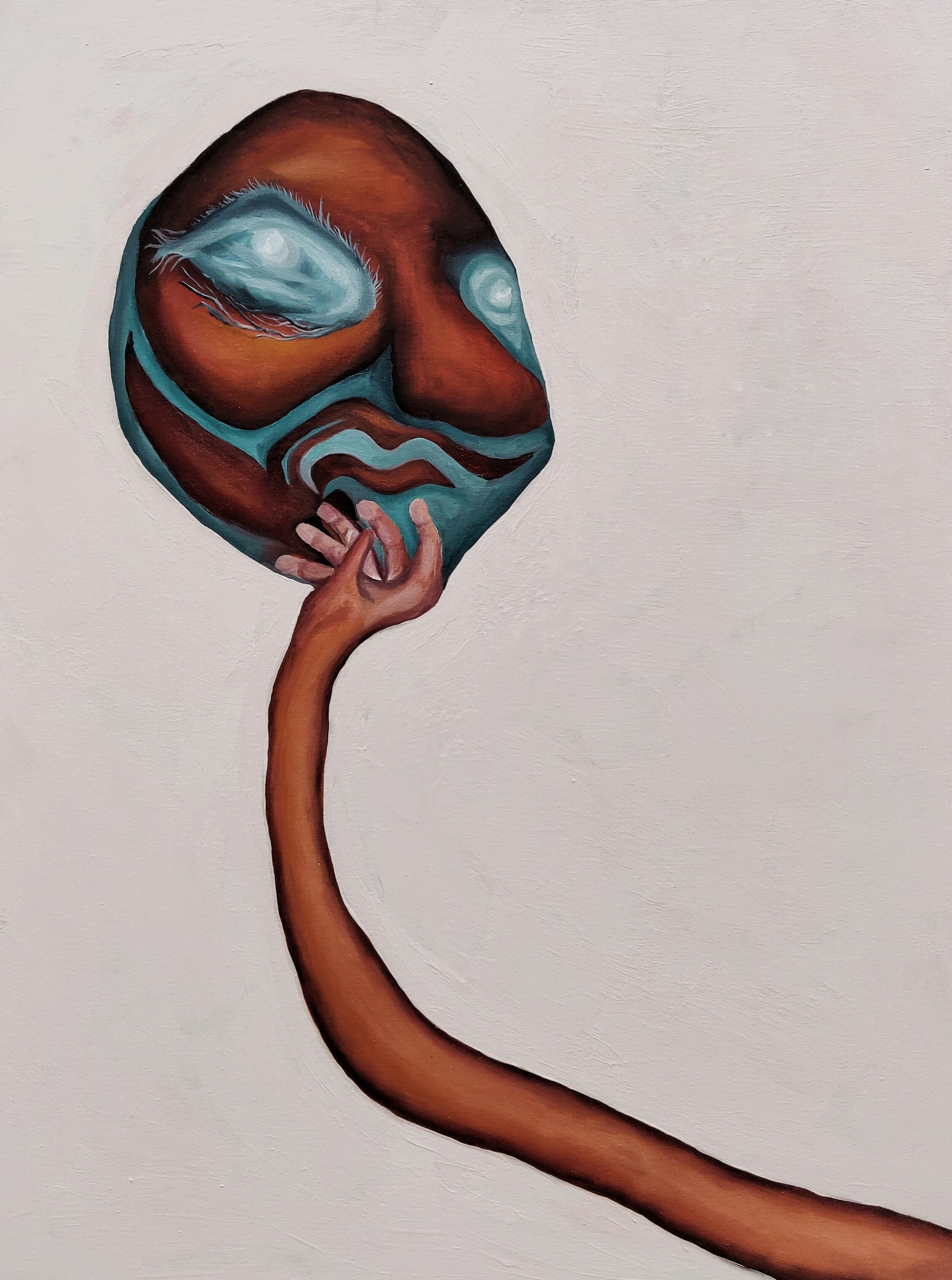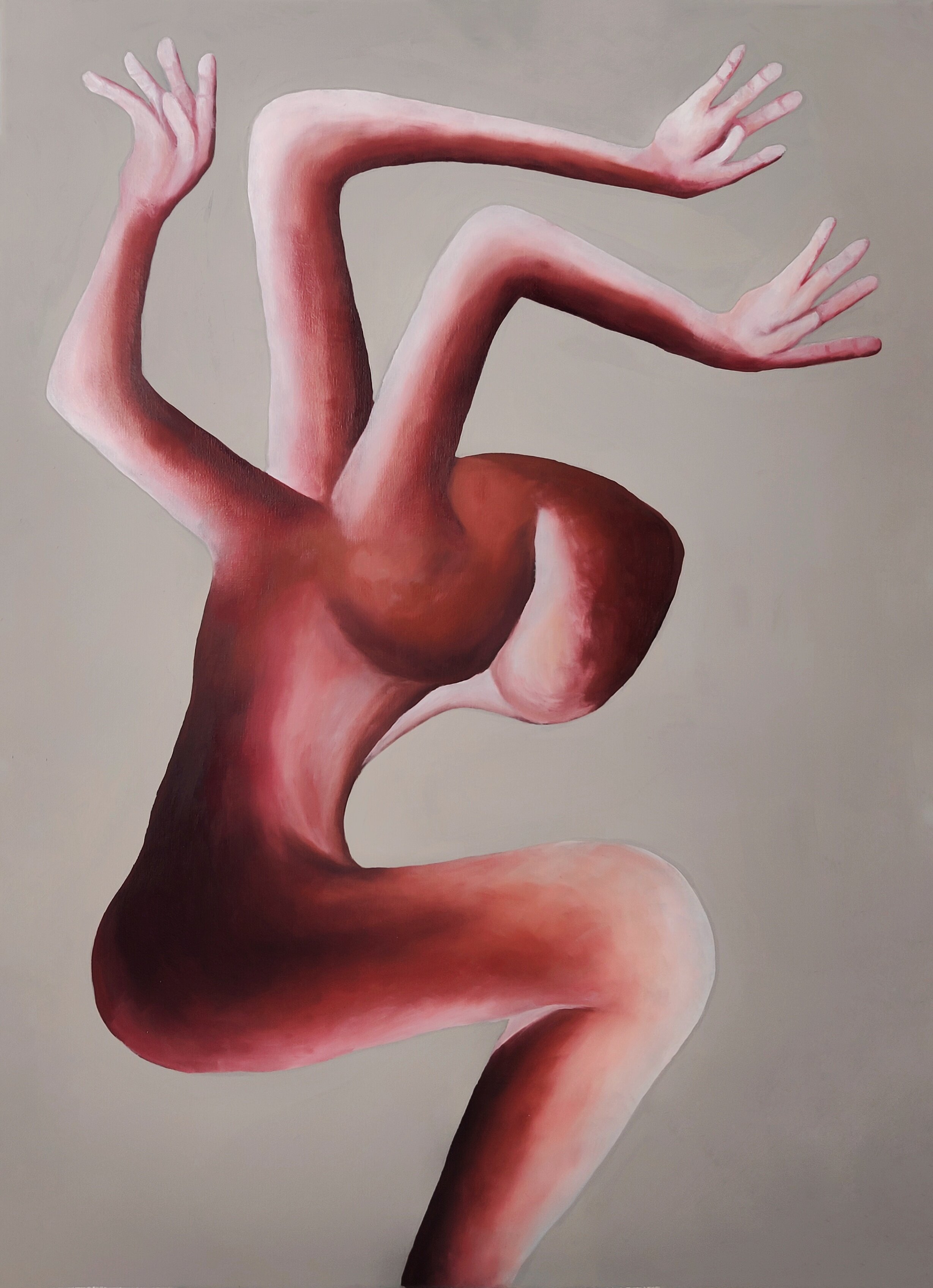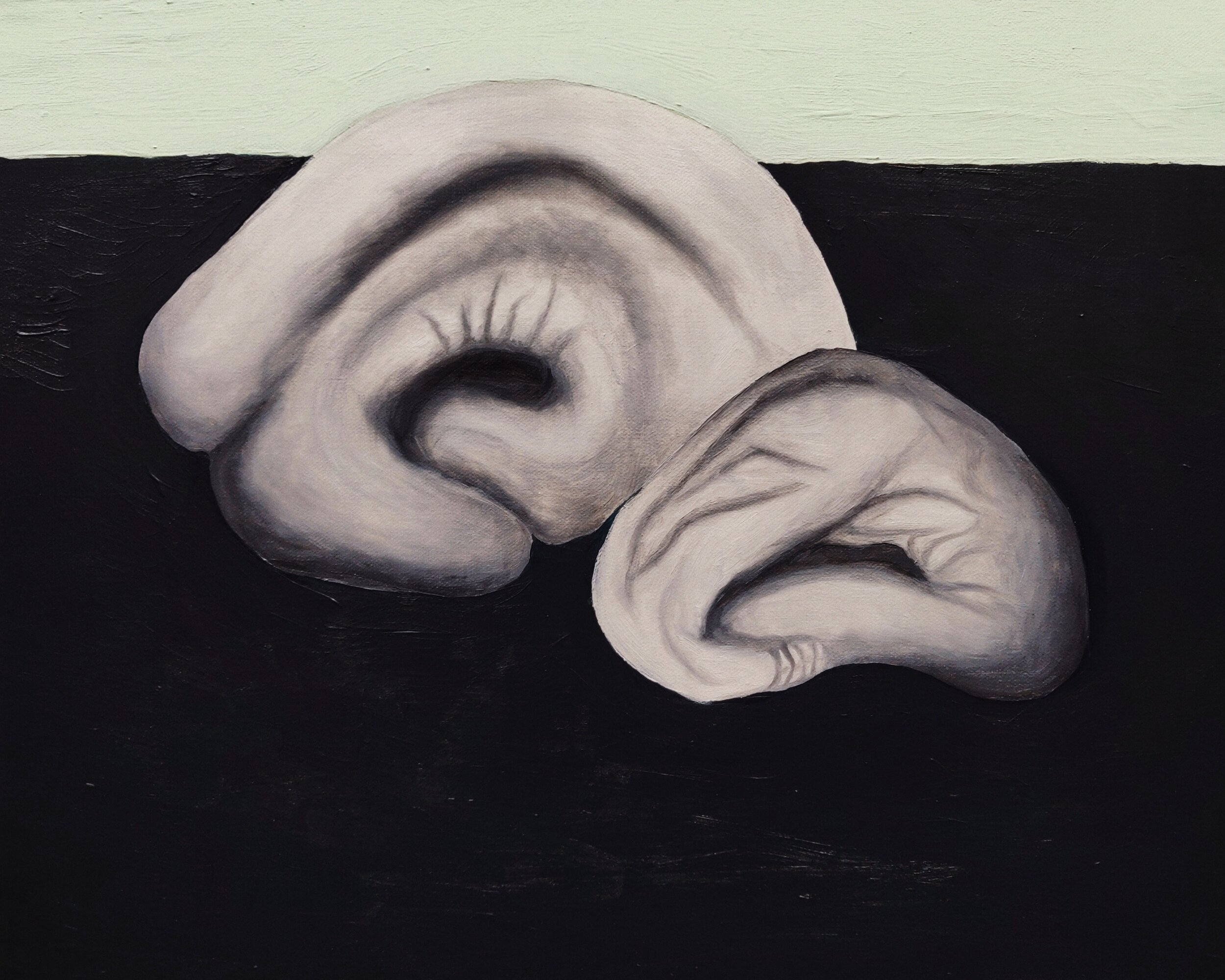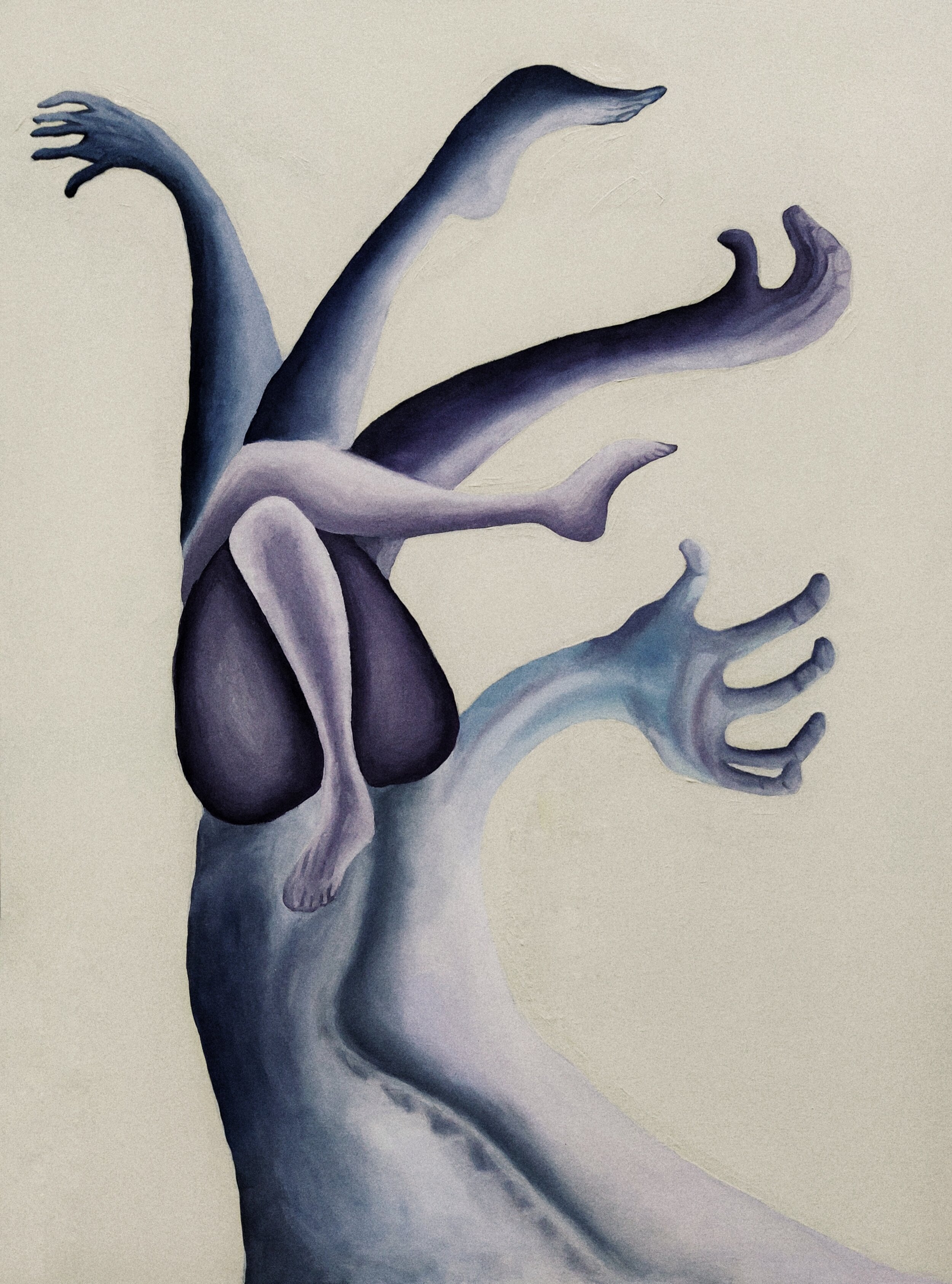Mia Osborne: Worlds Without Worlds.
‘BODY’ Series - Interview 2.
Mia Osborne is a highly imaginative artist who uses artistic mediums to explore alternative realities and dystopian possibilities. Her blending of human and plant characteristics, such as bioluminescent limbs, invites the viewer to discover otherworldly realms whilst raising awareness of environmental issues. Mia’s answers to the interview questions display a curiosity regarding psychology and the abstract, which I believe is shown through the symbolic imagery in her work.
‘In Flux’
You say this piece investigates interconnections with organic forms, and to quote you, the ‘flux between the human body and plant body’. What is this flux, and how does it relate to our connections?
In this piece, in particular, I felt a flux between human and plant body – limbs may mimic petals splaying out or stretched leaves extending towards the sky. Often, I feel the human physical body is imitated in natural forms, roots and branches feeling like a network of elongated arms and hands, twisting stems and trunks emulating twists and contortions of our moving form – almost as if they are frozen dancing bodies. Much like the body, natural forms are constantly in a state of change, growing and repairing in response to their surroundings and conditions. Faces and limbs seem to emerge from our environment, a reminder that as humans we are inescapably intertwined within it. I see these visual and sometimes subliminal similarities between our tangible forms and those in the natural world as an indication of our deeply embedded relationship with it. In an Earth where man-made objects have now overtaken natural matter in mass, I think this relationship can perhaps be easily forgotten. Through creating bodies inspired both by human limbs and by configurations of nature, I wish to reveal how we and nature may be recognised as a singularly functioning, meshed body.
However, whilst the natural world certainly inspires these bodies, ultimately, they are initially constructed and imagined via a digital means. I am fascinated by how the digital can allow us to construct new worlds, and how it feels like another planet in itself. Though being online may physically remove us from nature, it also allows us to see glimpses of it we would never see otherwise. The distortion of the human bodies is perhaps a reflection of how it feels being within a body in a virtual world; it seems space we spend so much of our time, but we don’t actually have physical interactions there, nothing is truly palpable (as of yet anyway). If imagining bodies walking round in virtual space, they feel strange, unrecognisable and warped. The virtual world, despite how realistic it may be, seems it can never compare to experiencing the beauty of the outside, natural world. Being in these digital spaces ever-increasingly brings a craving to be with nature even more; this magnetism towards it feels intrinsic, and something that should, in my opinion, never be lost.
You discuss removing the boundaries between us and nature. What are the boundaries your work explores, and how do you think we can overcome them?
I think a particular and significant boundary between humans and nature is a behavioural one on our part. So often nature is regarded by us as a resource to continuously exploit; habitats and environments destroyed simply so we can farm masses of grain. Often we don’t even share out these crops to feed other humans in the world starving, we use them to fatten up animals, then purchase and consume their slaughtered bodies. It’s of course all about money, greedy corporations really don’t give a shit if the world is a desolate wasteland in 100 years, they only care about their wealth now. If we saw ourselves and the natural world as one coiled anatomical form, – perhaps we’d show it a bit more compassion. We need to stop helping those who couldn’t care less about the future of nature, as if our own physicality and existence depends on it.
Understandably though, this can often feel extremely overwhelming, as it can feel out of our control. When governments and imperious companies feel practically in charge of the future of our world, what can we even do? A great starting point is to try and reconsider things we purchase and consume, to stop casting our vote for industries exacerbating the destruction of our world. When cattle farming is a major strain on our planet, with livestock covering 45% of the world’s land and animal agriculture responsible for 18% of greenhouse gas emissions, more than the combined exhaust from all transportation, stopping our support to this industry in particular feels essential for preserving the natural world.
What is your favourite bioluminescent creature and why do they influence your work?
I think I’d have to say my favourite is bioluminescent fungi, to be specific Mycena chlorophos. Unfortunately, I’ve never seen them in real life, only in photographs, but I just love how they look like little glowing lamp shades. I think this natural phenomenon feels so surreal and otherworldly, they feel as if they don’t belong in this world. When constructing the vaguely human bodies in my paintings, I imagined they shared perhaps a similar luminosity and were lustrous, metallic almost. Fungus in particular greatly intrigues me, due to its often fleshy and squashy quality, mimicking human skin. In the creatures I created, I was influenced by this idea of a body that radiates light and thought this quality could be interesting to explore in human limbs. It felt very alien to me, but a quality that would be genuinely be so cool to have.
Though not bioluminescent, I also really love the mushroom species Entoloma hochstetteri and Chlorociboria aeruginascens because they are so vibrantly beautiful.
A human-plant hybrid future! Please explain in detail what your plant-human future will include.
Well, when I was imagining a future where plants and humans have hybridised, I suppose it actually came from admittedly quite a pessimistic perspective, thinking of a world where humans have driven themselves into extinction. The world is no longer inhabitable to us: I imagined lots of human bodies sort of preserved within the soil of a fairly bleak world. Somehow, a mutation occurs with a plant growing and feeding off from these bodies. This mutation generates a growth of lots of human plant hybrids, where limbs act like giant succulent leaves. A whole array of new human plant species begins to inhabit the earth perhaps evolution is starting again, but we are now more plant than ever before. They are more than a human, they can withstand the planet despite its bleakness and destruction from a past species. More so than anything, it is nature reclaiming itself from the previous ruling of humans and forging itself as the now dominant species.
‘Extremophiles’
How does your work explore the limitations of the human body?
The creatures I imagine in my paintings have bodies more powerful than our own, they can withstand extreme temperatures and conditions. They are hybridised with the hardiest of plants, who have somehow survived the destruction caused by humans. The human body, though anatomically mind-blowing, feels ultimately still very fragile. If we continue to destroy the natural world at the rate we are, our bodies may not be able to withstand conditions on the planet for that much longer. I suppose my work envisions a species post-human, who are stronger and more resilient than us, but are directly intertwined with nature itself. Nature is no longer seen as something separated, but as a physical part of us.
My work also explores the limitations of the body when isolated. Multiple limbs in the beings work together in a network to complete their forms; we must work in cooperation with one another. The limbs form a more literal interpretation of a family tree.
Why the fingers? Do you always go for the same colouring for limbs?
In this piece, I used fingers as I was intrigued by the idea that the bodies were pointing and growing upwards from the scorched ground. The idea of an oversized thumb as a body also felt very imposing to me, if experienced in person I imagine them to be extremely large and towering over the human body as we now know it. I had never seen the sculptural work of ‘The Thumb’ by Cesar Baldaccini or ‘The Thumb’ by Salvador Dali before creating this piece, but have since recognised that they share an unusually similar form to my painting. Perhaps the image of a huge thumb is something psychologically and subliminally relevant to all of us; I know to me it felt incredibly striking, obtrusive and induced a sense of megalophobia in a way.
In terms of the colouring for the limbs, this is the colour palette I played with for the first of these paintings. I enjoyed how they perhaps mimicked bioluminescence and those mushrooms I love so much, but I have since also experimented with varying colouring for limbs, none of them really replicating the human body as we know it. The closest I’ve got to being similar to the human body I suppose is in my recent piece ‘Ventricular’, where the flesh is a deep crimson colour, kind of similar to muscle tissue.
Although the earth is destroyed, fingers seem to be growing out of the soil. Is there a deeper meaning behind this?
I see the fingers as nature reclaiming itself. It has mutated from limbs of the now extinct human body underneath the ground into strange hybrids of human and plant but is now growing and reaching forwards forcefully and defiantly, with no humans present to chop it down, trample or destroy it. The giant finger-cacti stand bolt upright, waving their limbs around, perhaps flexing their power and dominance to whoever is watching, inviting them into this new world, controlled by nature.
If you could give your body any plant-hybrid future adaption what would it be?
I think the adaptation I’d enjoy the most would be the regeneration and recovery properties that I Imagine these creatures to hold. If one of your limbs fell off for some reason, no problem, it’ll grow back soon enough. I’d also love to be resilient to temperature changes and extreme conditions – imagine what you could do with that. If I could detach from my roots some how I’d probably try and climb up a really high mountain of some kind and chill up the top for ages. That’d be amazing.







